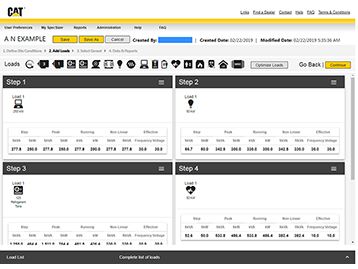Paralleled Generator Systems
Benefits of paralleling generators in onsite power systems are well documented. First, multiple generators in a system can increase reliability. Even if a system does not have fully redundant generation, load-prioritization schemes keep critical loads powered if a generator set fails. Next, generators can operate closer to their optimal load with demand schemes that take paralleled units offline when they’re not needed. Further, systems with multiple generators are more scalable, facilitating system expansion and capital project flexibility. Also, smaller units can have faster delivery times. Finally, paralleled units offer greater operational flexibility, facilitating routine maintenance.
Creating thoughtful design criteria helps convert the client’s goals into high-level technical requirements. These criteria establish design philosophy consensus early in the project, which can dramatically reduce rework down the road. This document is used throughout the project and defines the rest of the design process.
First, the design criteria outline the client’s commercial goals. For example, will they use the generation for interruptible service agreements where the utility provides financial incentives in exchange for generation support? Will they be operating in a baseload or peak-shave mode to help minimize demand charges? Or will the system be focused strictly on emergency or standby power?
Answering these questions is critical for the genset supplier and the design of the electrical distribution system. Also, these considerations define code and environmental requirements to which the project will be exposed. For example, NFPA 110: Standard for Emergency and Standby Power Systems has specific requirements for things like start time for emergency power systems. Also, the U.S. Environmental Protection Agency can have more stringent pollution-control requirements for generators that operate while normal power is available.
Next, the engineer should establish the critical loads and the reliability required. In some cases, not all loads are critical. Leveraging this fact can increase the overall reliability of the system, especially with paralleled generators. For example, if a single generator fails, noncritical loads can be shed or not added in the first place. This capability can essentially establish N+1 redundancy for critical loads, even though the overall system isn’t fully redundant. Conversely, if every load connected to the generation is essential, it’s crucial to know this early so the appropriate design precautions can be taken.
System reliability is a whole science by itself. Tools such as the IEEE 3006 Power System Reliability Standards can be very handy to study and quantify the reliability of different design concepts.
In addition to reliability, anticipated future expansion should be considered. This can establish spatial constraints that may otherwise not exist. For example, does the design need to leave room for an additional generator or does room need to be left for additional sections of switchgear? Does the electrical system need spare capacity for additional generation? Incorporating these things into the design from inception will result in a much cleaner final build-out.
Finally, applicable codes and standards should be compiled. Nothing is worse than finding out that a local code requires something beyond NFPA 70: National Electrical Code (NEC) requirements after construction has begun. Performing a review of applicable codes and standards at the beginning of the project can help the engineer refresh their memory and highlight pitfalls before design work begins in earnest. These can act as valuable guides during design. Also, the client’s insurance requirements should be reviewed to see if, for example, FM Global requirements are more stringent than the NEC.
Generation Capacity
After the design philosophy has been established, the required capacity for the generation system can be determined. This exercise requires a review of the facility’s load profile. If the generators will serve an existing system, actual metering data is very valuable here.
If this data is not available, however, load lists can be compiled to quantify the load. The designer must consider the expected harmonic content of the system, which may require generator derating. Also, starting requirements for large motors must be evaluated to make sure the alternators and exciters can provide the reactive power required. Note a general rule states that a generator should be sized 2.5 times larger than the largest motor it is required to start. Generator manufacturers have online software tools that can aid this effort.
Depending on the type of system, there are NEC requirements that must be considered as well. For example, generation systems are exposed to different requirements when they’re supplying emergency, legally required standby or optional standby loads. Specifically, when supplying emergency loads, NEC Article 700.4 states, “An emergency system shall have adequate capacity and rating for all loads to be operated simultaneously.” Alternatively, Article 702.4 allows for optional standby-capacity calculations to be made in accordance with Article 220. When demand factors are applied, this can offer some capacity relief.
While the criteria mentioned above will help the designer ensure enough capacity is provided, it is worth noting that having too much capacity can be a problem as well. This can expose the generator to problems such as wet stacking or fuel stagnation.
System Topology, Overall One-line Diagram
Once the required power is set, the overall one-line diagram is developed. This establishes the overall system topology identifying major pieces of electrical equipment and how they’re connected. Here, the engineer chooses the voltage levels that will be used. The 480-V generator is extremely common, and this voltage level has many benefits including the fact that a wide range of contractors and operators are familiar with it.
Also, generation at the same voltage as most of the loads can result in fewer electrical distribution components. When low-voltage systems result in bus ampacities of 4,000 to 5,000 amp and higher, installing cabling becomes difficult and incident energies become very high. In these cases, it may be time to consider medium-voltage systems, which have lower ampacities for the same amount of power. If multiple generators exist onsite, it is best to parallel them as opposed to keeping them isolated. This provides the redundancy benefits described above. Commonly, systems that call for paralleling two or more generators (G in Figures 1 and 2) do so with electrically operated circuit breakers (Figures 1 and 2). There are many different ways to connect this switchgear with the utility (U in Figures 1 and 2) and the loads. The best configuration depends upon the answers to a few critical questions.
Do the Generators Need to Parallel with a Utility? This is required when a facility operates in peak-shave mode, for example. These systems require that the generators and the utility simultaneously provide power to the loads, so there must be a way to connect the two together. This can be done with a utility breaker connected to the generator bus. If this is not required, a simpler isolated-bus configuration may be acceptable (see Figure 1). NEC Article 705 also has requirements for these applications.
Should Loads be Switched with Automatic Transfer Switches (ATS) or Electrically Operated Switchgear Breakers? ATS are easily procured and designed for a large number of switching operations. Plus, they may be required in emergency systems where code requires segregation of emergency loads. That said, performing utility/generator transfer in the paralleling switchgear can maximize factory wiring and minimize the electrical equipment footprint, making it a cost-effective way of implementing a full-facility backup system.
Is a Generator Bus Required? Generator buses connect all the generators together (Figures 1 and 2). This bus is then connected to load buses via tie breakers. Separate generator buses have the advantage of allowing generator-paralleling testing without disturbing the facility’s load. Plus, this seems to be the configuration with which generator suppliers are most accustomed. This allows the selection of standard designs that minimize the custom engineering required. However, the generator bus and corresponding required tie breaker(s) will increase cost and space requirements.
Are Redundant Utility Sources Required? If redundant utility sources are required, the switchgear will increase in complexity. These sources need to connect to the load bus in addition to the generators. This can be done with a main-tie-main configuration, with or without a generator bus. Alternatively, if the two utility sources don’t need to be able to feed the entire facility load, two separate load buses can be used, each powered from a utility/generator bus-transfer pair (Figure 2). In this configuration, each load bus would feed half of the facility load, saving a few tie breakers and some equipment ampacity.
Where do You put the Generator Breaker? Some manufacturers will put the switching device (contactor or breaker) on the generator skid itself. In this configuration, generator sets can essentially be daisy-chained together to connect to the load bus. In this configuration, the conductors implementing the daisy chain act as the generator bus. This can be economical for smaller units, but it can result in heavy cabling for larger systems, which can be cumbersome.
How Many Generators Should be Used? Lastly, because it has already been decided to use parallel generators, the engineer needs to determine how many to use. Should two units rated 100% each be used, or possibly three units rated 50% each? This is a question of both reliability and cost optimization. Generator set suppliers can provide budgetary information on their equipment that’s very valuable here.
Electrical Characteristics
After the major pieces of electrical equipment have been chosen, their details can be determined. Load-flow studies help define the continuous-current ratings required. It is important to model all of the system-switching configurations to determine the worst-case scenario. For example, if a main-tie-main switchgear lineup is to operate at full load from one utility source, then a single end must be able to handle the full facility load. Also, future expansion should be considered.
Next, a short-circuit study is performed. This study establishes the short-circuit ratings of the equipment, such as interrupting current and bus bracing. Again, when dealing with multiple generators and multiple utility sources, be sure to consider each possible switching configuration. Note that the line-ground fault current available from generators can be greater than their 3-phase fault current, so a complete short-circuit study must consider different fault types. This results from the fact that generators’ zero-sequence impedance is lower than their positive-sequence impedance. This is especially true in 2/3 pitch generators, which have very low zero-sequence impedance.
When paralleling different sources, available fault-current magnitudes can be quite high. When these sources are paralleled for long periods of time, the connected equipment should be rated to handle the total amount. Disagreement exists, however, when sources will only be paralleled for short amounts of time.
For example, consider systems fed by two redundant utility sources and paralleled generators. One school of thought here is that the equipment does not need to be designed to take into account the total fault current because both sources are rarely paralleled. The competing thought, however, is that when these sources are paralleled, switching is taking place, increasing the likelihood of a fault. The project team should carefully consider their approach and gain consensus among stakeholders.
System grounding is very important for paralleled generators, especially when they can parallel with the utility. Generators’ fault capability must be considered when choosing the system-grounding type. For example, because of the low generator zero-sequence impedance cited above, medium-voltage generators are often not braced to handle their own line-ground fault current when grounded solidly. Therefore, some type of impedance grounding is required. Common types are low-resistance, high-resistance, and reactance grounding.
Low-resistance grounding limits the fault current to hundreds of amps, high-resistance grounding limits the fault current to tens of amps, and reactor grounding typically limits the fault current to around 60% of a 3-phase fault current. Higher impedances have the advantage of less line-ground fault current and help reduce circulating current; however, caution should be exercised when generators are paralleled with other solidly grounded sources like wye-windings of utility transformers. Too high a grounding impedance on a generator connected to a solidly grounded source will cause the line-ground fault current in that source to rise. This may exceed the equipment’s capability. For this reason, reactor grounding is often selected when generators are paralleled with solidly grounded components.
Finally, when deciding on system-grounding types, the varying levels of fault currents resulting from different switching configurations should be considered. This can cause problems with protective relaying when the available fault current varies over too wide a range.
Protection, Control, and Metering
At this stage, additional details defining how the system is metered, controlled, and protected can be defined. Two primary approaches are employed here. Some engineers will performance-specify the major aspects of their system and let the generator supplier work out the details. This is efficient from an engineering effort standpoint and works well for typical, off-the-shelf systems.
On projects with more customization or integration with existing systems, more detail may be required from the specification engineer. When this is the case, a protection, control, and metering one-line diagram may be produced in lieu of a prescriptive specification. After all, a picture is worth a thousand words.
This detailed one-line diagram shows the major protection and control equipment required. Some primary examples are the protective relaying, the master control cabinet, or a manual synchronization panel (if required). It also shows what signals are exchanged among these devices.
For example, the master control cabinet may need to know the breaker statuses from the paralleling switchgear or voltages from different points in the system. This requires that breaker auxiliary contacts and potential transformer circuits be wired to the cabinet. Other examples include contacts from lockout relays that trip in the event of a bus fault. The master controls need these signals so they don’t close the generators on a faulted bus.
Finally, these types of drawings are especially important when the generator set vendor is not the same as the paralleling switchgear vendor. Detailed drawings can help coordinate the two.
Note that when paralleling with the utility, a number of additional protective-relaying elements are required. For example, some utilities require that a distributed-generation system be provided with anti-islanding that shuts down generation when a segment of the utility circuit has opened. This helps prevent the generation from powering a local area of the utility’s system, which can be hazardous to linemen.
Additionally, reverse real and reactive power protection are often required to ensure the utility isn’t motoring the generator and that the onsite generation isn’t exporting more power to the utility than agreed upon. Directional overcurrent protection can also be a valuable tool when generator systems are paralleled with the utility. These schemes help facilitate coordination in these systems with multidirectional power flow.
To take it one step further, three-line diagrams may also be required, which further define the protection system. At least a partial three-line diagram can be useful in detailing ground-fault protection. For example, this helps answer questions like:
- Should the neutral be switched when the load is transferred?
- Will all of the generators’ neutrals be bonded at a single point in the switchgear?
Power systems with paralleled generators can provide many benefits to facility owners, both from an economic and reliability standpoint. To realize these benefits, it is important that the consulting and specifying engineers use the tools at their disposal and apply sound engineering principals to the application. This is especially true with the increasing diversity of projects and the complexity that can come from paralleling generators.
Joseph Thornam is a principal electrical engineer at Stanley Consultants.
Stanley Worcester is the chief electrical engineer at Stanley Consultants.












